American Elm
Ulmus americana
Family: Ulmaceae
Natural History

Leaves and branch of American elm | Photo credit: Larry Korhnak, University of Florida
The American elm is a moderately large tree, 80-120 feet in height and two to five feet in diameter. It usually has a heavily buttressed bole that divides several feet above the ground into a number of gracefully arching limbs, forming an attractive, vase-like or spreading crown of pleasing symmetry and beauty.
It is a fast-growing tree that once shaded many streets in the eastern United States. Those avenues changed dramatically, however, when Dutch elm disease reached the U.S. in 1930, in a shipment of elm logs from Europe. The disease quickly spread across the northeastern states - killing millions of American elms in forests and cities.
Dutch elm disease is caused by a fungus that disrupts the vascular system - causing wilting and eventual death within two months. The fungus is spread by bark beetles and root grafts. To prevent the spread of the disease, infected trees need to be quickly removed, and the root connections to neighboring trees need to be cut.
Dutch elm disease has not yet been detected in Florida, but arborists watch elms closely for the symptoms, so any outbreak can be quickly quarantined and controlled.
